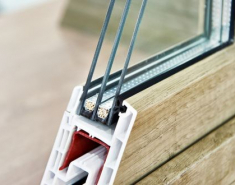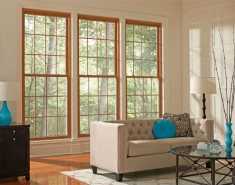A Window for Today
Windows have always been at the intersection of various technologies and architectural processes that evolved in parallel and often intertwined.
Last century’s breakthroughs in terms of glass and frame allowed the glass to progressively absorb functions traditionally present in other devices ultimately dissolving the window into transparent walls. Nowadays, smart windows intersect previous technologies with electrically activated materials with dynamic properties augmenting their capacity.
In this paper, we speculate on an idea of the window of the future according to state of the art in terms of glass and operable frames. We argue that a possible outcome of the combination of different technologies — magnetic and dynamic levitation, transparent photovoltaic glass, vacuum insulated glass, switchable glass, piezoelectric touch-sensitive surfaces or ultra-thin glass — might ultimately change the architectural approach to windows.
1. More glass, fewer windows: what is a window?
Imagining the future of the window is not an easy task. It is not even clear whether windows, as single recognizable operable devices, will still exist. Emerging in western architecture as apertures punctured in enclosing walls [1], to introduce light into buildings, admit air and provide framed views to the outside, they are spatial mediators of the relation between interior and exterior like glass doors, which additionally allow movement.
Therefore they work as filters, being historically accompanied by a series of devices that regulate light, ventilation, privacy, and atmospherical conditions. Some provide shading — shutters, louvers, jealousies, blinds, screens and curtains —, others security — bars, grills, storm sashes, handles and bolts —, while others — seats, sills, bow-windows, meshes — express different architectural approaches, varying according to climate conditions, cultural roots and social issues.
Over time, designers envisioned new architectural possibilities for glass doors and windows, which evolved in parallel and often intertwined with various glass and frame technologies and frame. The window as a hole progressively faded away as last century’s improvements allowed the size of glass panes to grow, undifferentiating windows and glass doors, and culminating in the glass curtain wall, which simultaneously expanded the window encompassing the entire façade and dissolved it into fully glazed skins.
Furthermore, during the 20th century, closed façades become prominent, especially in corporate buildings, with windows that provide uninterrupted views to the exterior but prevent any physical contact with it, as mechanized ventilation systems absorbed the function of air supply. Industrialization, on the other hand, sacrificed the genealogy of window and its local specificities, institutionalizing global practices and standard requirements of thermal efficiency, fire resistance, airtightness and waterproofness.
Tempered glass also played an essential role in this evolution, allowing glazing to perform a structural function, which was until then prohibited. With all these changes, windows lost their autonomy as isolated elements and their role as visual framing agents. Glass as a screen wrapping (parts of) the façade replaced the anthropomorphic metaphor of windows as the “eyes” of the building, challenging the traditional concept of window.
Indeed, while historically, one tends to identify windows as the transparent parts of a given façade, the advent of large glass walls challenged the identification of the window and its profile. One could still identify its essence on the operable parts of transparent enclosures, which offer not only views of the outside but practical possibilities of physical contact with the exterior.
2. Smart materials, smart glass: intelligent windows?
More recent breakthroughs in terms of glass technology rendered glass truly dynamic, efficiently congregating the different features and possibilities traditionally present in a multi-layered system of filtering devices into a single architectural element with (almost) no thickness. It is a radical mutation in the approach to the scale of walls and openings. Indeed, glass alone can now efficiently control solar gains and radiation with coatings, incorporate blinds or meshes in its cavity, provide unmatched insulation with triple glazing or vacuum glass, dynamically change its opacity and temperature, and ultimately generate energy and convey digitized information converting windows in electronic displays.
This shift is achievable mainly through the potential of programmable materials and artificial intelligence methods which promise to enhance the use of our day-to-day objects and devices, bridging and interconnecting them to form “master” devices with uses and applications never thought before. Despite being an old material, glass assumes a predominant role in this revolution, with increasing architectural applications — in windows and façades and also in many different parts of the building structure and devices — as many novel materials and technologies are developed in combination with it.
Therefore, glass functions both as a structural material, with customizable mechanical properties thanks to the improvements in the material itself, and as a base for energy management and interactive systems through coating and printing technologies that implement features that functionalize it actively and passively.
Besides lamination for intrusion prevention, high-selectivity coatings for radiation control, layers for heated glass or digital display, the incorporation of interactive functionalities through sensors, displays and actuation capabilities, render glass and windows a vital element of the concept of the “internet of things”. The materials that allow these features are so-called “smart materials”, which are generally grouped into property-changing, energy-exchanging and matter-exchanging [4]. Many are ready for implementation, while others are still under development or commercial applicability.
Triggered by light, temperature, pressure, electric and magnetic fields or the chemical environment, they provide functions that are applied to glass leading to “smart glasses” and “smart windows”, intersecting previous technologies with electrically activated materials offering interactivity or switchable properties. Relevant examples of dynamic solutions for glass and windows include:
1. control of optical transmittance, introducing variations in light transmittance in the visible spectrum to manage solar radiation and privacy as well as decorative issues thanks to materials with colour and optically changing properties under light, thermal or electrical stimuli passively (photochromic or thermochromic) or actively (electrochromic).
2. control of thermal transmittance, through the management of wavelengths up to the infrared region of the electromagnetic spectrum; the adequate control of radiation transmission and thermal absorption will enable implementation of energy saving strategies for heating and cooling buildings.
3. memory and shape (or dimension) changing properties under thermal, electrical or magnetic stimuli that can be applied to windows in the development of controllable joints and sealing components with expansive materials;
4. adhesion changing materials, allowing active or passive control of hydrophobicity of the surface, enabling the implementation of self-cleaning glass or aluminium profiles or antibacterial agents.
5. photoluminescent smart materials, fluorescent, phosphorescent and electroluminescent materials, enabling specific various lighting possibilities;
6. piezoelectric and magnetoelectric materials, allowing the implementation of ceramic or polymer sensors and actuators in glass;
7. photoluminescent smart materials, including self-luminous glass for windows and skylights;
8. photoelectric and thermoelectric materials, enabling the application of energy generation, storage and management, notably with solar cells for photovoltaic glass or thermoelectric generators.
9. heat storage materials, contributing to energy efficiency management.
10. implementation of “transparent electronics”, with sensors, actuators and display capabilities, enabling the highest levels of interactivity and energy management.
Thus, glass “alone” can actively determine the visual, luminous, thermal and acoustic control of environments. Nevertheless, the vast majority of available solutions with dynamic properties is still far from being truly interesting in an architectural point of view. Available switchable glass or photovoltaic glasses, for example, are yet intermediate solutions, imposing to renounce some features: total opacity for electrochromic glass
3. The virtual window: from metaphor to reality
A recurrent view for the “window of the future” is the emerging ability of glazing to convey digitized information, sometimes as a window’s virtual analogue. However, OLED capacitive screens features seem more suited to interior elements — TV or computers, interactive tables, glass partitions, displays — or mobile devices rather than the buildings’ exterior envelope.
The applications they promise — electronics enabled, touch sensitive, ultrathin, flexible and with advanced functionalities like 3D-projection or augmented reality [9] — can decisively be more useful in automotive design or handheld display devices than façades. Curiously, in 1435, Leon Battista Alberti’s famous treatise De pictura regarded painting as “an open window [finestra aperta] through which the historia is seen” [10], a metaphor commonly referred as the origin of the comparison of the window and picture that has shaped Modern Western thinking about images and the way of seeing the world [11]. Windows are certainly a compelling metaphor for paintings as much as screens, but the real ability of windowpanes to display digitized information seems the step to push Alberti’s metaphor beyond.
Many past predictions of the future explored this idea, besides speculating on cities of glass, invisible glass-made characters [12], electronic eyeglasses and goggles, or nightviewing glass implants [13]. A curious example is Slow Glass [14], a glass-like substance with such a large refractive index that light takes significant time, even several years, to pass through it. It thereby functions as a screen to the past, or more accurately as a limited time viewer.
Source: https://bit.ly/3c48ZKQ









